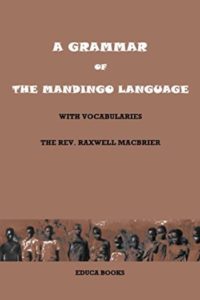
*The Mandingo language is celebrated on this date in 1000. Also known as Mandinka, it is a Mande language spoken by the Mandinka people of Guinea, northern Guinea-Bissau, the Casamance region of Senegal, and the Gambia, where it is one of the principal languages. Mandinka belongs to the Manding branch of Mande and is like Bambara and Maninka/Malinké but with only five instead of 7 vowels. It is a tonal language with low and high tones in most areas. However, the variety spoken in the Gambia and Senegal borders on a pitch accent due to its proximity to non-tonal neighboring languages like Wolof. There is little dialectical diversity. Mandingo is represented by the type spoken in Casamance.
Tone
Mandingo has two tones, high and low. Unmodified nouns are either high tone or low tone on all syllables. The definite suffix -o takes a low tone on high-tone nouns and a falling tone on low-tone nouns. It also assimilates any preceding short vowel, resulting in a long /oo/ with either a low or falling tone. It shortens a preceding long high vowel (ii > io, uu > uo; ee optionally > either eo or ee) or assimilates itself (aa remains aa), leaving only its tone:
/búŋ/ 'a room' > /búŋò/ 'the room'
/tèŋ/ 'a palm tree' > /tèŋô/ 'the palm tree'
/kídí/ 'a gun' > /kídòò/ 'the gun'
/kòrdàà/ 'a house' > /kòrdáà/ 'the house'
In Senegal and Gambia, Mandingo is approaching a system of pitch accents under the influence of local non-tonal languages such as Wolof, Serer, and Jola. The tonal system remains strong in the Eastern and Southern Mandinka dialects (Tilibo) spoken in Guinea-Bissau, Guinea, and Eastern Senegal. These conservative dialects merge into other traditional Manding languages like Maninka, the once official language of the Mali Empire, Bambara, and Susu. All of these preserve the typical West African terraced down step in tonality that is only lightly alluded to in the Western Mandinka dialects spoken in much of Gambia and Senegal. Vowels Vowel qualities are /i e a o u/. All may be long or short. There are no nasal vowels; instead, there is a coda consonant,/ŋ/. Long vowels are written double: aa, ee, ii, oo, uu.
Consonants
The following table gives the consonants in the Latin orthography and their IPA equivalent when they differ. Syllabic nasals occur in, e.g., nnààm 'yes!' (response), ŋte "I, me". Word-initial mb, nd, ndy, and ng occur but are not particularly common; it is unclear whether they should be considered syllabic nasals or additional consonants. Consonants may be geminated in the middle of words (at least /pp, cc, jj, kk, ll, mm, nn, ññ/). The only other consonant found at the ends of syllables in native words is /ŋ/. It assimilates to the following consonants: /ns, nc, mb/, etc. Syllable-final /r/ and /s/ are found in French loans (e.g., /kùrtù/ "pants").